Qingqing Wu
Low-Altitude ISAC with Rotatable Active and Passive Arrays
Dec 24, 2025Abstract:This paper investigates a low-altitude integrated sensing and communication (ISAC) system that leverages cooperative rotatable active and passive arrays. We consider a downlink scenario where a base station (BS) with an active rotatable array serves multiple communication users and senses low-altitude targets, assisted by a rotatable reconfigurable intelligent surface (RIS). A rotation-aware geometry-based multipath model is developed to capture the impact of three-dimensional (3D) array orientations on both steering vectors and direction-dependent element gains. On this basis, we formulate a new optimization problem that maximizes the downlink sum rate subject to a transmit power budget, RIS unit-modulus constraints, mechanical rotation limits, and a sensing beampattern mean-squared-error (MSE) constraint. To address the resulting highly non-convex problem, we propose a penalty-based alternating-optimization (AO) framework that alternately updates the BS precoder, RIS phase shifts, and BS/RIS array rotation angles. The three blocks are efficiently handled via a convex optimization method based on quadratic-transform (QT) and majorization-minorization (MM), Riemannian conjugate gradient (RCG) on the unit-modulus manifold, and projected gradient descent (PGD) with Barzilai-Borwein step sizes, respectively. Numerical results in low-altitude geometries demonstrate that the proposed jointly rotatable BS-RIS architecture achieves significant sum-rate gains over fixed or partially rotatable baselines while guaranteeing sensing requirements, especially with directional antennas and in interference-limited regimes.
A Covariance-Surrogate Framework for Movable-Antenna Enabled Anti-Jamming with Unknown Jammers
Dec 23, 2025Abstract:In this paper, we investigate a movable antenna (MA) enabled anti-jamming optimization problem, where a legitimate uplink system is exposed to multiple jammers with unknown jamming channels. To enhance the anti-jamming capability of the considered system, an MA array is deployed at the receiver, and the antenna positions and the minimum-variance distortionless-response (MVDR) receive beamformer are jointly optimized to maximize the output signal-to-interference-plus-noise ratio (SINR). The main challenge arises from the fact that the interference covariance matrix is unknown and nonlinearly dependent on the antenna positions. To overcome these issues, we propose a surrogate objective by replacing the unknown covariance with the sample covariance evaluated at the current antenna position anchor. Under a two-timescale framework, the surrogate objective is updated once per block (contains multiple snapshots) at the current anchor position, while the MVDR beamformer is adapted on a per-snapshot basis. We establish a local bound on the discrepancy between the surrogate and the true objective by leveraging matrix concentration inequalities, and further prove that a natural historical-averaging surrogate suffers from a non-vanishing geometric bias. Building on these insights, we develop a low-complexity projected trust-region (TR) surrogate optimization (PTRSO) algorithm that maintains the locality of each iteration via TR constraints and enforces feasibility through projection, which is guaranteed to converge to a stationary point near the anchor. Numerical results verify the effectiveness and robustness of the proposed PTRSO algorithm, which consistently achieves higher output SINR than existing baselines.
Cooperative Rotatable IRSs for Wireless Communications: Joint Beamforming and Orientation Optimization
Dec 16, 2025Abstract:Rotatable intelligent reflecting surfaces (IRSs) introduce a new degree of freedom (DoF) for shaping wireless propagation by adaptively adjusting the orientation of IRSs. This paper considers an angle-dependent reflection model in a wireless communication system aided by two rotatable IRSs. Specifically, we study the joint design of the base station transmit beamforming, as well as the cooperative passive beamforming and orientation of the two IRSs, to maximize the received signal-to-noise ratio (SNR). Under the light-of-sight (LoS) channels, we first develop a particle swarm optimization (PSO) based method to determine the IRS rotation and derive an optimal rotation in a closed-form expression for a two-dimensional IRS deployment. Then, we extend the design to the general Rician fading channels by proposing an efficient alternating optimization and PSO (AO-PSO) algorithm. Numerical results validate the substantial gains achieved by the IRS rotation over fixed-IRS schemes and also demonstrate the superior performance of the double rotatable IRSs over a single rotatable IRS given a sufficient total number of IRS elements.
Intelligent Reflecting Surfaces for Integrated Sensing and Communications: A Survey
Nov 14, 2025

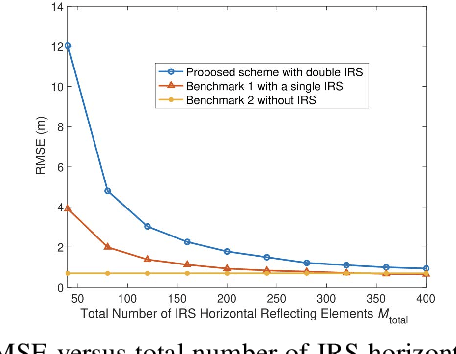
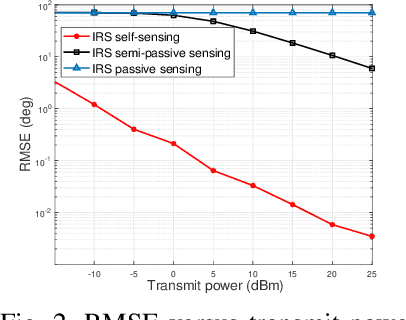
Abstract:The rapid development of sixth-generation (6G) wireless networks requires seamless integration of communication and sensing to support ubiquitous intelligence and real-time, high-reliability applications. Integrated sensing and communication (ISAC) has emerged as a key solution for achieving this convergence, offering joint utilization of spectral, hardware, and computing resources. However, realizing high-performance ISAC remains challenging due to environmental line-of-sight (LoS) blockage, limited spatial resolution, and the inherent coverage asymmetry and resource coupling between sensing and communication. Intelligent reflecting surfaces (IRSs), featuring low-cost, energy-efficient, and programmable electromagnetic reconfiguration, provide a promising solution to overcome these limitations. This article presents a comprehensive overview of IRS-aided wireless sensing and ISAC technologies, including IRS architectures, target detection and estimation techniques, beamforming designs, and performance metrics. It further explores IRS-enabled new opportunities for more efficient performance balancing, coexistence, and networking in ISAC systems, focuses on current design bottlenecks, and outlines future research directions. This article aims to offer a unified design framework that guides the development of practical and scalable IRS-aided ISAC systems for the next-generation wireless network.
Reconfigurable Airspace: Synergizing Movable Antenna and Intelligent Surface for Low-Altitude ISAC Networks
Nov 13, 2025Abstract:Low-altitude unmanned aerial vehicle (UAV) networks are integral to future 6G integrated sensing and communication (ISAC) systems. However, their deployment is hindered by challenges stemming from high mobility of UAVs, complex propagation environments, and the inherent trade-offs between coexisting sensing and communication functions. This article proposes a novel framework that leverages movable antennas (MAs) and intelligent reflecting surfaces (IRSs) as dual enablers to overcome these limitations. MAs, through active transceiver reconfiguration, and IRSs, via passive channel reconstruction, can work in synergy to significantly enhance system performance. Our analysis first elaborates on the fundamental gains offered by MAs and IRSs, and provides simulation results that validate the immense potential of the MA-IRS-enabled ISAC architecture. Two core UAV deployment scenarios are then investigated: (i) UAVs as ISAC users, where we focus on achieving high-precision tracking and aerial safety, and (ii) UAVs as aerial network nodes, where we address robust design and complex coupled resource optimization. Finally, key technical challenges and research opportunities are identified and analyzed for each scenario, charting a clear course for the future design of advanced low-altitude ISAC networks.
Rotatable IRS Aided Wireless Communication
Nov 13, 2025Abstract:Rotatable intelligent reflecting surface (IRS) introduces a new spatial degree of freedom (DoF) by dynamically adjusting orientations without the need of changing its elements' positions in real time. To unleash the full potential of rotatable IRSs for wireless communications, this paper investigates the joint optimization of IRS rotation angles to maximize the minimum expected signal-to-noise ratio (SNR) over all locations within a given target area. We first propose an angle-dependent channel model that accurately characterizes the reception and reflection of each IRS element. Different from the conventional cosine-law assumption, the proposed model captures the practical electromagnetic characteristics of the IRS, including the effective reception area and reflection efficiency. For the single target location case, a particle swarm optimization (PSO)-based algorithm is developed to solve the SNR maximization problem, and a closed-form expression for a near-optimal solution is derived to provide useful insights. For the general area coverage enhancement case, the optimal rotation is obtained through a two-loop PSO-based iterative algorithm with null-point detection. In this algorithm, the outer loop updates the global rotation angles to maximize the minimum SNR over the target area, whereas the inner loop evaluates the SNR distribution within the area to identify the location corresponding to the minimum SNR through null-point detection. Numerical results demonstrate significant SNR improvement achieved by the proposed rotatable IRS design over various benchmark schemes under different system setups.
Low-Altitude UAV-Carried Movable Antenna for Joint Wireless Power Transfer and Covert Communications
Oct 30, 2025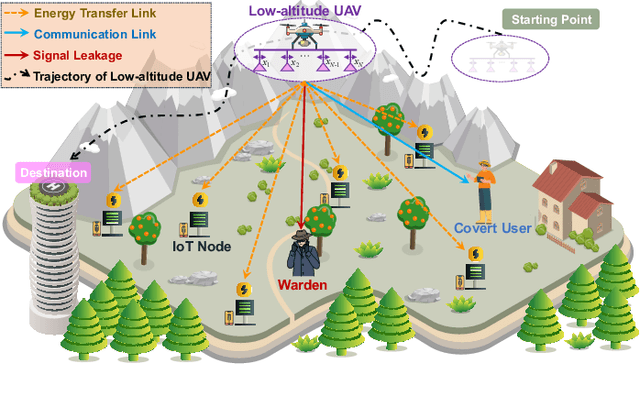
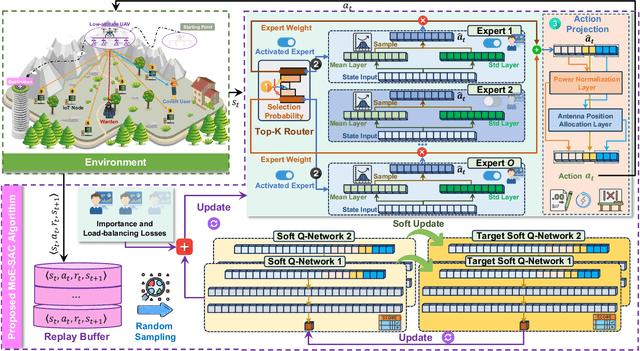
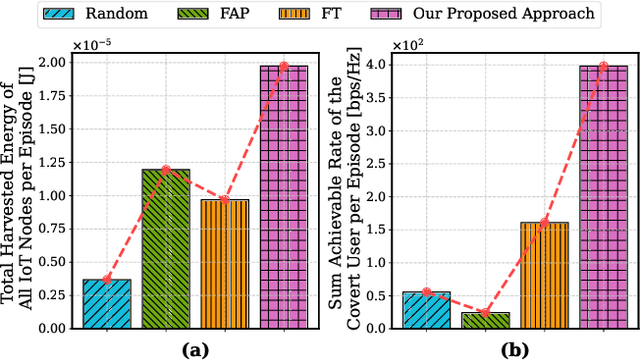
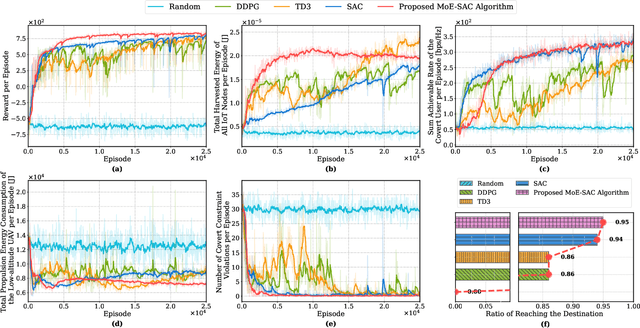
Abstract:The proliferation of Internet of Things (IoT) networks has created an urgent need for sustainable energy solutions, particularly for the battery-constrained spatially distributed IoT nodes. While low-altitude uncrewed aerial vehicles (UAVs) employed with wireless power transfer (WPT) capabilities offer a promising solution, the line-of-sight channels that facilitate efficient energy delivery also expose sensitive operational data to adversaries. This paper proposes a novel low-altitude UAV-carried movable antenna-enhanced transmission system joint WPT and covert communications, which simultaneously performs energy supplements to IoT nodes and establishes transmission links with a covert user by leveraging wireless energy signals as a natural cover. Then, we formulate a multi-objective optimization problem that jointly maximizes the total harvested energy of IoT nodes and sum achievable rate of the covert user, while minimizing the propulsion energy consumption of the low-altitude UAV. To address the non-convex and temporally coupled optimization problem, we propose a mixture-of-experts-augmented soft actor-critic (MoE-SAC) algorithm that employs a sparse Top-K gated mixture-of-shallow-experts architecture to represent multimodal policy distributions arising from the conflicting optimization objectives. We also incorporate an action projection module that explicitly enforces per-time-slot power budget constraints and antenna position constraints. Simulation results demonstrate that the proposed approach significantly outperforms some baseline approaches and other state-of-the-art deep reinforcement learning algorithms.
Wireless Sensing with Movable Intelligent Surface
Sep 19, 2025Abstract:Future wireless networks are envisioned to deliver not only gigabit communications but also ubiquitous sensing. Reconfigurable intelligent surfaces (RISs) have emerged to reshape radio propagation, recently showing considerable promise for wireless sensing. Still, their per-element electronic tuning incurs prohibitive hardware cost and power consumption. Motivated by the concept of fluid antenna system (FAS), this paper introduces a low-cost movable intelligent surface (MIS) for wireless sensing, which replaces element-wise electronic phase tuning with panel-wise mechanical reconfiguration. The MIS stacks a large fixed and a smaller movable pre-phased metasurface layers, whose differential position shifts synthesize distinct composite phase patterns, enabling multiple beam patterns for multi-target detection. We characterize a MIS-enabled multi-hop echo signal model with multi-target interference and then formulate a worst-case sensing signal-to-interference-plus-noise ratio (SINR) maximization problem that jointly designs MIS phase shifts and schedules MS2's position. A Riemannian Augmented Lagrangian Method (RALM)-based algorithm is developed to solve the formulated mixed-integer non-convex problem. We also derive a heuristic MIS beam steering design with closed-form phase distribution and position scheduling. Simulations validate MIS's beam pattern reconfiguration capability, show that the RALM-based scheme significantly outperforms the closed-form scheme in improving sensing SINR, and uncover a gain-diversity trade-off in beam patterns that informs the optimal choice of MIS configuration.
Hierarchical Federated Learning for Social Network with Mobility
Sep 18, 2025Abstract:Federated Learning (FL) offers a decentralized solution that allows collaborative local model training and global aggregation, thereby protecting data privacy. In conventional FL frameworks, data privacy is typically preserved under the assumption that local data remains absolutely private, whereas the mobility of clients is frequently neglected in explicit modeling. In this paper, we propose a hierarchical federated learning framework based on the social network with mobility namely HFL-SNM that considers both data sharing among clients and their mobility patterns. Under the constraints of limited resources, we formulate a joint optimization problem of resource allocation and client scheduling, which objective is to minimize the energy consumption of clients during the FL process. In social network, we introduce the concepts of Effective Data Coverage Rate and Redundant Data Coverage Rate. We analyze the impact of effective data and redundant data on the model performance through preliminary experiments. We decouple the optimization problem into multiple sub-problems, analyze them based on preliminary experimental results, and propose Dynamic Optimization in Social Network with Mobility (DO-SNM) algorithm. Experimental results demonstrate that our algorithm achieves superior model performance while significantly reducing energy consumption, compared to traditional baseline algorithms.
Low-Altitude UAV Tracking via Sensing-Assisted Predictive Beamforming
Sep 16, 2025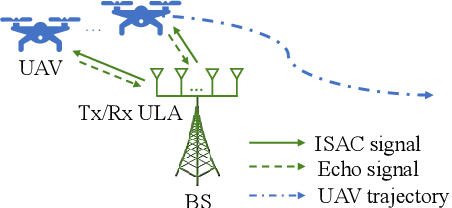
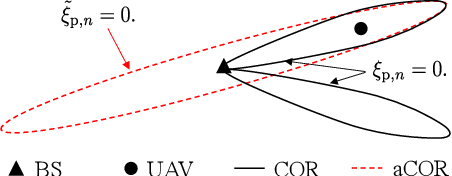

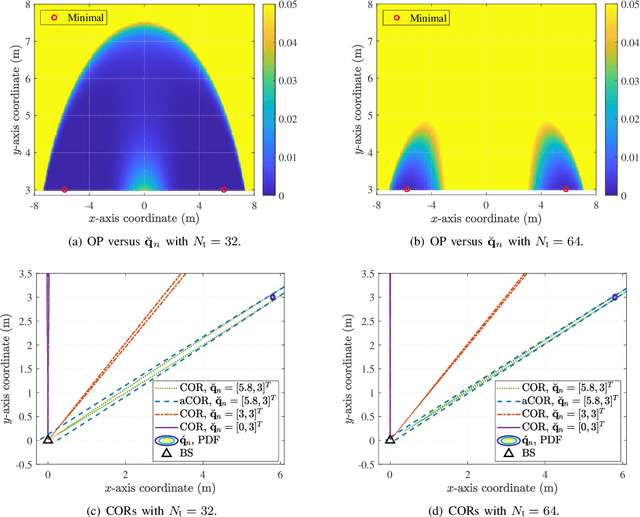
Abstract:Sensing-assisted predictive beamforming, as one of the enabling technologies for emerging integrated sensing and communication (ISAC) paradigm, shows significant promise for enhancing various future unmanned aerial vehicle (UAV) applications. However, current works predominately emphasized on spectral efficiency enhancement, while the impact of such beamforming techniques on the communication reliability was largely unexplored and challenging to characterize. To fill this research gap and tackle this issue, this paper investigates outage capacity maximization for UAV tracking under the sensing-assisted predictive beamforming scheme. Specifically, a cellular-connected UAV tracking scheme is proposed leveraging extended Kalman filtering (EKF), where the predicted UAV trajectory, sensing duration ratio, and target constant received signal-to-noise ratio (SNR) are jointly optimized to maximize the outage capacity at each time slot. To address the implicit nature of the objective function, closed-form approximations of the outage probabilities (OPs) at both prediction and measurement stages of each time slot are proposed based on second-order Taylor expansions, providing an efficient and full characterization of outage capacity. Subsequently, an efficient algorithm is proposed based on a combination of bisection search and successive convex approximation (SCA) to address the non-convex optimization problem with guaranteed convergence. To further reduce computational complexity, a second efficient algorithm is developed based on alternating optimization (AO). Simulation results validate the accuracy of the derived OP approximations, the effectiveness of the proposed algorithms, and the significant outage capacity enhancement over various benchmarks, while also indicating a trade-off between decreasing path loss and enjoying wide beam coverage for outage capacity maximization.
 Add to Chrome
Add to Chrome Add to Firefox
Add to Firefox Add to Edge
Add to Edge